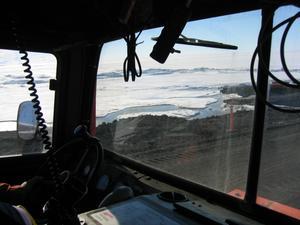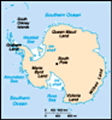Advertisement
Published: February 3rd 2005

 A View From a Hagglunds
A View From a Hagglunds
The Hagglunds is one of the loudest vehicles on earth, but it is now one of my favorite - It will go anywhere.My first glimpse at deep field living in Antarctica happened at Snow School 1, AKA Happy Camper School. The day started at nine in the morning, after putting a few hours of work in, when the twelve of us who were going on the training met in the field-training classroom. After discussing many things, including the dangers of a cold environment and the contents of our survival bags, we loaded into an amphibious Hagglunds, which is a snow vehicle that will float and drive across water, and began our trip out to the Ross Ice Shelf. Once there, we met at the I-hut, which stands for Instructor Hut, we ate lunch and learned about expedition planning in preparation of our night in the field. We then gathered our sleeping kits, which took a lot of teamwork to assemble, and walked the quarter-mile to snow mound city, our home for the night. The Hagglunds dropped off our gear near a storage shed with additional gear and from there we loaded sleds and pulled everything to our campsite. The first priority, once you are in the field, is to get shelter. On a planned expedition this is an easy task, because you just

 The Hagglunds
The Hagglunds
This was taken at camp on the Ross Ice Shelf.put up the tents - We were using a Scott tent, which is of the same design used on Scott’s expeditions and is one of the best suited tents for the harsh Antarctic Climate, and three mountain tents. If you are in a survival situation, which this class focuses a great deal on, or if conditions are not well suited for a tent then you can build a Quinzy, which is an Antarctic adaptation of a snow cave. In Antarctica there is not a lot of loose snow and to build a proper snow cave, such as on mountaineering expeditions, you need deep but firm snow, so here you can pile up all of your bags and bury them with the surface snow to a depth of three feet, building a dome of snow in the process. Once the bags are buried, you let the mound sit and consolidate for a while and you start digging your opening. The entrance should be lower than the floor of the inside sleeping area, here it requires tunneling - We picked a spot that would be away from the directions the wind should come from, which is from the South and from the

 Camp and The Scott Tent
Camp and The Scott Tent
The yellow tent is called a Scott tent because it is of the same design as the ones used 100 years ago by Scott. It is one of the best suited tents to the Antarctic environment.North off the slopes of Erebus, and we started digging. Once the hole was about three feet deep, we turned and began tunneling using an ice axe and shovels to slowly chip the ice away. Up top, the Quinzy had settled and a hole was dug through the side to allow the bags to be pulled out. Once the bags were out we smoothed the inside of the shelter into the shape of a dome and I began tunneling down to try and meet our other tunnel and complete the entrance. After about two feet of digging I began to see a deep blue glow coming from the bottom of the hole and in another foot I broke through. We widened the tunnel so that I could crawl through and discovered that we had perfectly joined the two ends, which was surprising. We patched the hole in the wall and continued sculpting the inside of the dome and widening the tunnel so that the most claustrophobic in the group could get inside and we called it done - Finally, I have completed my first tunnel in the snow. We also learned how to build a snow wall and then we

 The Quinzy
The Quinzy
This is the above ground snow cave that we built during class. Look at that lovely tunnel!made dinner under the constant gaze of the Skuas, which are large sea gull like birds. After dinner, many of the group went to sleep and the rest of us went exploring. I walked down a flagged route, which means it has been checked for crevasses and is safe, to Silver City, where a safety hut, a large icefall and a crevasse field are, to take some pictures and enjoy the warming sun and the amazing scenery. Silver city was a small insulated building with a few bunk beds that could be ‘camped’ in during good weather, but a large storm with 180 mph winds came through last winter and destroyed the building so now it is just an apple hut. On the way back to camp, the sun was at an angle that amplified the beauty of the surrounding mountains and as I walked along, I contemplated the remoteness of this place with nearly featureless, flat, desert of ice as far as I could see in many directions. I got back to camp, took a few more pictures and climbed into my snow cave for the evening.
I woke up in the morning well rested and ready to

 The Tunnel
The Tunnel
This is a view from inside the Quinzy hut looking out the tunnel.start the day. My hut was very warm and comfortable - I didn’t even have to zip up the sleeping bag or use the provided bag liner. It took me a while to get dressed and packed up due to the cramped quarters and chilly air inside the Quinzy, but I managed to have everything dragged out and put into the gear pile on time. The weather was still clear, but the wind was howling and the wind chill was below zero making every activity a chore. Most of the other people in the group had gotten up a lot earlier and had the water boiling and ready for breakfast. Breakfast consisted of plain oatmeal, which was hard to keep in the cup because of the wind, and chocolate bars - The breakfast of champions! We launched a cup of boiling water into the air and it was nearly frozen by the time it hit the ground and I was told that in the winter it will be frozen before it lands - I am going to try it again then. After breakfast we packed up and walked back to the I-hut to continue class. We discussed radios and then

 Looking from Where I Came
Looking from Where I Came
This is the flagged route that I followed over to Silver City - It is looking accoss the Ross Ice Shelf.we broke up into groups and set-up HF radios and called McMurdo Station and the South Pole Station on them - That was a lot of fun! During the radio class one of the guys started showing signs of hypothermia and I was the person that noticed it and took action - turns out it was a test, pre-arranged by the instructor, although it was supposed to take place later during the test scenario. For the test scenario, we had to build a snow wall with at least ten blocks, set up a tent, boil a quart of water and call McMurdo Station on the radio, all in twenty minutes or less. We got to work and made good time with all but the tent, which took a little more time than expected, so we finished about two minutes late - Oh well. We returned to McMurdo and did a short helicopter and dry valley training and class was done.
In all, Happy Camper School was a lot of work, but was a great experience and a lot of fun. I hope I will be able to do a few more outings before I leave here, but I know

 The Apple Hut at Silver City
The Apple Hut at Silver City
This is a survival hut on the Castle Rock trail. Mt. Erebus is in the background.there will not be many opportunities during the winter. Today the supply vessel made it through the ice to the ice pier and offload has begun. During offload, all of the bars are closed and the station becomes a hectic place. I saw a few members of the Russian crew from the icebreaker Krasin in the coffee house trying to buy wine, but it was not being sold either - They finally get their shore leave and everything is closed!
Advertisement
Tot: 0.044s; Tpl: 0.016s; cc: 6; qc: 24; dbt: 0.0202s; 1; m:domysql w:travelblog (10.17.0.13); sld: 1;
; mem: 1mb









peter hebbing
non-member comment
scott tent
hello, the yellow tent that you call a scott tent, would you know the brand of this ? best regards, hope to hear from you. Peter